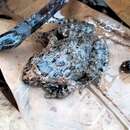Description
provided by AmphibiaWeb articles
This species has the unusual situation where males (50mm) are larger than females (40mm) and the males have noticeably much broader heads than the females. They are an olive green to almost black above and often have some dark flecking, splotching and/or variegations on the back. There are also sometimes warts on this skin and some females from upland areas of northern NSW have a mid-dorsal stripe. Males have a black belly with white spots whereas females have a belly with black and white marbled. The rest of the underside is dark with some white spotting. Both sexes have orange to red patches in the groin, the thighs and even down to the feet. Both males and females have two pseudo-dentary teeth sticking up from the tip of the lower jaw and these tusks give the species its common name. The tusks are somewhat larger in the males and are thought to be used mainly in territorial encounters when looking for or holding on to calling sites. Males in captivity have been observed to “lock jaws” by grabbing each other’s mouths.This frog is reasonably distinguishable from all other Australian frogs by the combination of the orange or red patches in the groin and on the thigh and the presence of the black and white belly. Pseudophryne toadlets have the black and white belly, but not the patches. Uperoleia toadlets have the groin and thigh patches, but not the black and white belly.
- Czechura, G.V. (1986). ''Distant exiles: Frogs and reptiles recorded from Kroombit Tops SEQ.'' Queensland Naturalist, 26(1-4), 61-67.
- Katsikaros, K. and Shine, R. (1997). ''Sexual dimorphism in the Tusked Frog, Adelotus brevis (Anura: Myobatrachidae) the roles of natural and sexual selection.'' Biological Journal of the Linnean Society, 60, 39-51.
- author
- J.-M. Hero
- author
- Harry Hines
- author
- Ed Meyer
- author
- D. Newell
Distribution and Habitat
provided by AmphibiaWeb articles
Range and Population Disjunct population in the Clarke Range (mid-eastern Queensland) then from Shoalwater Bay (mid-eastern Queensland) south along the coast to Moss Vale (mid-eastern New South Wales) and inland to Blackdown Tableland and Carnarvon Gorge. The extent of occurrence of the species is approximately 480700 km2. This frog remains reasonably common throughout its entire range and is still so today in the lowland areas. In the mid to late 1970s however, it disappeared from the New England Tablelands for reasons that are still not clear. It is presumed that land clearing, habitat alteration, loss of water quality, spread of exotic fish species (eg, plague minnow) and disease and all had some part to play in this decline. The only populations recorded on the Tablelands in recent years have been seen in the Nowendoc area, at the very southern end of the Tablelands. For this reason, the New England Tablelands population of this frog has recently been listed as an Endangered Population under the Threatened Species Conservation Act.HabitatTusked frogs are found through a broad range of habitats covering open grasslands, large swamps, low woodlands, dry and wet sclerophyl forests and rainforest and appear none too concerned about whether the site is natural or artificial or whether it is pristine or highly disturbed. They rarely occur above 400m asl and will breed in quite a broad range of sites for an Australian frog, being found wherever there is relatively still water. They have been observed calling (rarely) in temporary pools on the sides of roads, in larger flooded depressions, in permanent fire dams and ponds and on the banks of small to quite large streams. In the faster flowing streams the tadpoles probably stick to specific microhabitats to avoid being washed around too much.
- author
- J.-M. Hero
- author
- Harry Hines
- author
- Ed Meyer
- author
- D. Newell
Life History, Abundance, Activity, and Special Behaviors
provided by AmphibiaWeb articles
The tusked frog has a calling season that usually extends through the warmer months although, the majority of calling occurs between September and December. Males usually call from within the water hiding under rocks or accumulated debris, within or under emergent/overhanging vegetation or from within tunnels/burrows in the banks of the water body. They are adaptable too with one male known to regularly call from under the wheel hub of an old car. The call is a soft “b’look” repeated regularly (described in Martin Robinson’s field guide as a “tok” or “chuck”). An important point to note about the call is that it is distinctly, albeit subtly, in two parts (b followed by look). It is this that distinguishes the call of the tusked frog from the quite similar “tok” call of the striped marsh frog (Limnodynastes peronii). The eggs are unpigmented and laid into a foam nest that is concealed underneath vegetation and/or debris. An adult male has been observed dragging eggs on to the egg mass to conceal it, probably a first for this type of parental care in Australian frogs. The eggs hatch after several days and the tadpoles take an average of 2-3 months to reach metamorphosis. The tadpoles are an unremarkable brown colour and grow up to around 30mm in size. Development is usually complete within 71 days.
- author
- J.-M. Hero
- author
- Harry Hines
- author
- Ed Meyer
- author
- D. Newell
Life History, Abundance, Activity, and Special Behaviors
provided by AmphibiaWeb articles
Dead frogs that have suffered chytrid fungus have been found in south-eastern Queensland and north-eastern New South Wales. The major threat to the species, however, is loss and degradation of habitat through agricultural and urban development.Conservation MeasuresIn protected areas the species is safe from habitat loss. Research into the spread of chytrid fungus and education on methods of minimising and preventing its spread.
- author
- J.-M. Hero
- author
- Harry Hines
- author
- Ed Meyer
- author
- D. Newell

